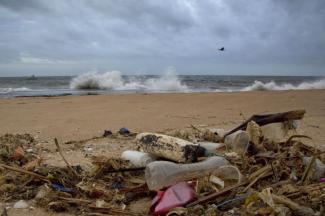Limits to growth
Preventing systemic collapse

The foundations for the world’s dominant economic systems were laid in the 19th and 20th centuries, when the world was still “empty”. When John Maynard Keynes developed his economic theory, for instance, there were fewer than 2.5 billion people on earth. They produced far less compared to today. Natural resources were abundant, and the earth could easily absorb the impact of the people’s lifestyles and economic habits.
Presently, the world is home to 7.6 billion people with a high level of industrialisation and destructive consumption habits. The old system is no longer working. This is the thesis of the report “Come on! Capitalism, short-termism, population and the destruction of the planet”, published to commemorate the 50th anniversary of the Club of Rome in 2018. Forty-five years after the international think-tank first drew global attention to the issue of unsustainable growth with its famous report “The limits to growth”, the Club of Rome has now published another comprehensive analysis. The work was done by the current co-presidents Ernst Ulrich von Weizsäcker and Anders Wijkman, along with 33 other Club members.
Part 1 of the book offers an overview of current crises and threats to the planet. It touches on topics like climate change, population growth, urbanisation, the glut of plastic waste and nuclear weapons. In order to measure the status of the earth, the authors rely on the concept of planetary boundaries, which was developed by a group of international scientists led by Johan Rockström and Will Steffen (2009). Back then, the scholars identified nine such boundaries, which are also called thresholds or tipping points:
- stratospheric ozone depletion,
- biodiversity loss and species extinction,
- chemical pollution and the emission of novel compounds,
- climate change,
- ocean acidification,
- land use,
- freshwater use and the global water cycle,
- the flow of nitrogen and phosphorus into the biosphere and the oceans and
- atmospheric aerosol loading.
Some limits, like biodiversity loss and interference with the nitrogen and phosphorus cycles, have already been transgressed, others are classified as “growing risks”, including climate change and changes in land use. Yet others, like freshwater use and the depletion of the ozone layer, are still within a safe operating space. Scientists have not yet defined a boundary level for chemical pollution and aerosol loading.
Most of the insights collected in “Come on!” are not new, but they are alarming nevertheless. The focus is less on the causes of the acute threats to our planet than on options to respond. The third and last section is dedicated to solutions.
The middle section deals with the our civilisation’s ”philosophical crisis”. Indeed, part 2 calls for a new enlightenment. The authors consider it the most revolutionary section. It addresses environmental ethics and world religions. Their underlying thesis is that current religions and ways of thinking arose in the era of the “empty world” and are thus poorly suited to the “full world”. The starting point for this analysis is “Laudato Sí”, the 2015 encyclical by Pope Francis that calls on humanity to completely re-think our relationship with nature. Of course, texts concerning human responsibility towards nature are found in all world religions.
The authors offer an explanation for why some religions, including the Abrahamic faiths, contain statements about the dominion of people over nature: “Going back to the origins of the major religions of the world, it should be recognised that they all emerged at times when nature seemed robust and endless, and the relatively few humans were threatened by hunger, wild animals, unknown diseases and neighbouring tribes.” After all, the world was still “empty”. In our current “full world”, however, the mandate to “be fruitful and multiply; fill the earth and subdue it” can no longer be applied.
Another basic evil, according to the authors, is the radical market-orthodoxy that became paradigmatic after 1989. It emphasises liberalisation, deregulation and privatisation – and the result is globalisation, which has led to cut-throat competition between states and has produced many losers. The Club of Rome does not fundamentally condemn the market economy, but it criticises phenomena like growing inequality, the “dictates of the financial system” and the “arrogance” of global capitalism.
Balance should be one of the main features of the new enlightenment, between for instance:
- people and nature,
- short- and long-term,
- speed and stability,
- public and private,
- men and women,
- social justice and incentives for excellence and
- faith and state.
Yet we cannot wait for these new guidelines to be implemented worldwide. As the authors point out, “total system collapse is a real possibility”. Humanity must act now, as part 3 makes clear (see also box below). In that section, the authors share a variety of success stories, concerning, for instance, grasslands regeneration in Mexico and Zimbabwe through holistic management. Moreover, alternative development strategies are creating millions of jobs in rural India, and China is transitioning to a green economy. Part 3 is an explicit attempt to spread optimism. The authors are convinced that it is still possible to facilitate a future of prosperity for all people – but only if economic growth is decoupled from the consumption of natural resources.
Some of their claims are radical. This one is an example: Full national sovereignty over actions that affect the entire globe is no longer legitimate. It seems unlikely that the UN will determine in the near future whether a country may build coal-fired power plants or allow more vehicles that burn fossil fuels on its streets. However, the call to take integrated approaches in economic, social and environmental affairs reflects the idea of sustainability that the global community adopted with the 2030 Agenda. The Sustainable Development Goals are designed to solve as many of humanity’s problems as possible. But the Club of Rome warns that achieving the 11 socio-economic SDGs may imply trampling the environmental ones by bringing about the swifter ruin of the climate, ocean and biodiversity.
Sources
Von Weizsäcker, E. U., Wiijkman, A., et al., 2017: Come on! Capitalism, short-termism, population and the destruction of the planet. New York, Springer.
Rockström, J., Steffen, W., et al., 2009: Planetary boundaries. Exploring the safe operating space for humanity. Nature 461: 472-475.








